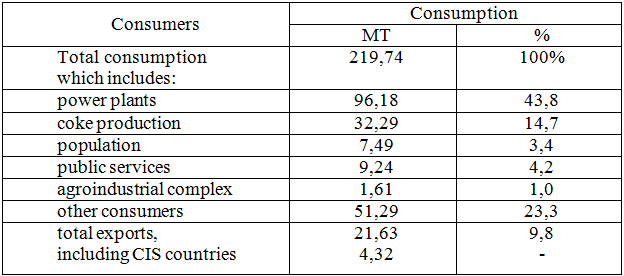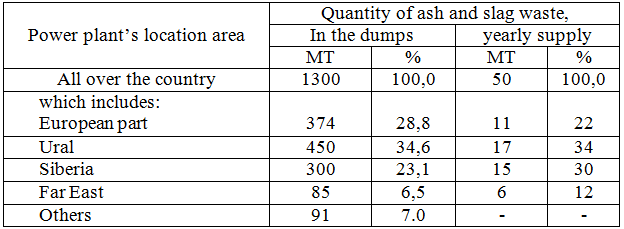ПРОБЛЕМЫ КОМПЛЕКСНОЙ ПЕРЕРАБОТКИ ЗОЛОШЛАКОВЫХ ОТХОДОВ
Кузьмина Т.И.
Доктор экономических наук, Московский государственный машиностроительный Университет
ПРОБЛЕМЫ КОМПЛЕКСНОЙ ПЕРЕРАБОТКИ ЗОЛОШЛАКОВЫХ ОТХОДОВ
Аннотация
В статье рассматривается опыт различных стран в решении проблемы утилизации золошлаковых отходов, рассмотрены существующие организационные формы и методы экономического стимулирования для предприятий, направленные на снижение антропогенного давления на окружающую среду.
Ключевые слова: утилизация, твердые отходы углеобогащения, золошлаковые отходы.
Kuzmina T.I.
Doctor of Economics, Moscow State University of Mechanical Engineering
PROBLEMS OF COMPLEX RECYCLING OF ASH AND SLAG WASTE
Abstract
The paper investigates the experience of different countries in solving the problem of disposal of ash and slag waste, considers the existing organizational forms and methods of economic incentives for companies aimed at reducing anthropogenic pressure on the environment.
Keywords: recycling, solid waste coal, ash and slag waste.
Disposal of ash and slag waste of heat power plants is a long-term nationwide objective of the inter-sectoral nature. In our country, due to the use of substandard coal with high ash content there are problems with collection, placement and storage of ash and slag waste.
Currently, coal, oil shale and peat account for about 30% of the fuel balance of the country and mostly used for production of electricity, heat and metallurgical coke. The directions of use of the main type of solid fossil fuels (coal and lignite) are presented in Table. 1.
Table 1-Directions of use of coal [1,54]
The data of Table 1 clearly demonstrate that major mass consumer of coal is heat power plants. Simultaneously, it should be emphasized that the power plants, as a rule, are supplied with coal of lower quality in comparison with other consumers. As a result, the share of thermal energy facilities account for about 27% of the emissions of all sectors of industry and transport.
The list of the major environmental pollutants from power plants should include ash and slag, sulfur and nitrogen oxides. Among these substances, the greatest anthropogenic impact on the environment has ash. Here is some information on the extent of evolution and ways of using ash and slag waste of power plants.
At present the total area of ash and slag dumps on the territory of Russia reached 20 thousand hectares. Storage volumes and annual supply of ash and slag waste are presented in table. 2.
Table 2 – Formation of ash and slag waste [2,55]
Ash and slag wastes are mostly used for the construction of dams, repair and construction of roads, production of cement, aerated concrete, cinder blocks, bricks and expanded clay. However, in recent years there has been a tendency to decrease the volume of recycling of ash and slag waste.
The main reasons for the low level of usage of these wastes in our country is the lack of a systematic approach to the problem, the desire to impose this task on one industry – energetics and attempts to implement these decisions by legislative means. The consequence of such approach are:
- lack of economic interest in processing of slag waste;
- most of the ash dumps are poorly organized (in particular, lack of rail and automobile access roads);
- lack of transport and equipment for the transport and processing of waste, as well as lack of companies producing such transport and technical means;
- Insufficient funding for establishment of industries engaged in waste recycling;
- insufficient use of the results of domestic and foreign research and development work and international experience;
The spread of the false idea of the abundance of natural resources, as well as the absence of strong economic leverages, limiting the consumption of natural resources and promote the use of waste, hamper an increase in consumption of ash and slag.
The level of recycling of ash and slag waste abroad reaches 40-70%. In Germany, for example, 80% of the buildings are constructed with the use of such waste. Similar situation emerges in Poland, France, Italy and China. In the USA the overall rate of utilization of ash and slag waste makes up about 20% of their output; they are used in construction of roads, dams, filling of underground workings, construction of embankments and bedding. For example, the company "Baltimore Gas and Electric Co." used ash and slag mixture for the construction of embankment area of 185 hectares for the erection of production facilities, thus solving the problem of storing its waste for 15 years. Currently about 300 of waste management projects are implemented in the United States, each of which involves the use of more than 1 million tonnes of waste. There are promising state program of transfer of raw-material base of the enterprises on extraction of rare metals from mineral ores in the ash wastes. There is promising long-term program for alteration of raw material base of companies extracting rare metals that considers replacement of mineral ores by ash and slag waste.
In our country, material intensive means of ash and slag waste recycling are not developed. Research and technological development in this domain is rare, it has not had practical results yet and is poorly stimulated. In the UK, for example, power plants were nationalized, and sales of waste are carried out through the regional offices. In France the sales of the waste are done by private corporations. The power plants are equipped with systems of transportation and storage of ash, which is shipped conditioned in accordance with the requirements of consumers. Poland introduced important charges for the land withdrawn under the ash dumps. These funds are allocated for the implementation of environment protection measures.
In the United States national association for the disposal of ash and slag waste was created, which includes government agencies and private firms. It registers all plants, generating ash and slag, determines directions of its use, develops recycling technology, organizes prototype production, is engaged in advertising. Prices for waste are set depending on settlements between the power plants and firms – intermediaries. The latter transports ash and slag waste, carries out inexpensive conditioning and sells them to consumers. In this case, payment to intermediaries for the removal of ash is significantly lower than cost of storing waste in the ash dumps. Intermediaries return part of the profit to power plant.
In Germany and some other countries, the problem of disposal of ash and slag waste is solved by organizing of production of building materials and products on the basis of power plants. Production of cellular concrete and cellular concrete products, as well as other wall materials seems to be the most promising. Cellular concrete is not the only direction that efficiently uses the ash and slag wastes. According to American experts, production of bricks from waste is considerably cheaper than from clay.
In Russia there are attempts to solve the problem of use of ash and slag wastes using methods of economic impact. For the purposes of economic incentive for the gradual reduction of the rate of increase of ash dumps’ areas separate standards for payments were set for the withdrawn land: an increase in ash disposal areas within the regulated limits and exceeding those limits. In the latter case, payments are increased in multiple dimensions that affect the economic interests of power plants’ teams.
Other proposals for the creation of economic levers are being worked out to make unprofitable occupation of new premises by ash dumps of thermal power plants unprofitable. Measures to make consideration of applications for extraction of non-metallic materials more thorough are being taken, if there are ash dumps in the region.
The use of ash waste in any single direction inevitably generates new waste with all ensuing consequences. The most effective from an environmental point of view is the comprehensive utilization of ash and slag waste.
Waste of TPP (thermal power plants) in different regions may be disposed in different ways. The main direction of comprehensive utilization is determined by the combination of specific properties of the actual waste and needs of the region. So, brown coal of the Kansk-Achinsk basin in combustion is giving ash, which has an alkaline reaction. The massive use of this ash in agriculture in the region is relevant, as around 0.5 million hectares of land are oxidized. However, active work on soil deoxidation by adding ash waste are not carried out in the region.
The study of foreign and domestic experience of recycling of solid ash and slag waste of thermal coal-fired power plants showed that in the world practice there are two major organizational approaches to the problem, complementary regional and national.
A regional approach should be based on the independence of the regions increasing in our country, and hence on expanding capacity of local authorities to allocate these resources. At the same time, the responsibility of the territorial authorities for the environment, housing and food problems, infrastructure development and energy supply increases. In particular, almost everywhere there are or may be established companies for the production of building materials, which should be focused on the use of ash and slag wastes of thermal power plants as raw materials – which will reduce the transportation of natural materials and products.
Introducing any of the approaches (regional or national) the need to coordinate and monitor progress of work on the formation and disposal of ash and slag waste in the country remains as well as development of industrial and scientific and technical capacity in this area, and creation of economic, resource and information support.
The challenge of developing and implementing the means to limit ash exits from the combustion of solid fuel and maximize utilization of waste generated is complicated and huge. It will require not only mobilization of internal forces, but broad and diverse international cooperation: joint elaboration of major projects, cooperation in development and manufacture of technical equipment, purchase of equipment and other forms of interaction.
References
- Kuzmina T.I. Classification of coal waste - the basis of choice of methods of their use. Scientific periodical «IN SITU», №1 (1) / 2015.
- Kuzmina T.I. Ecological and economic efficiency of solid waste coal (coal ash) in the production of alumina - the raw material for aluminum industry. «International Research Journal» International Research Journal. Yekaterinburg, 2015


